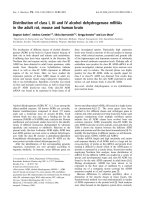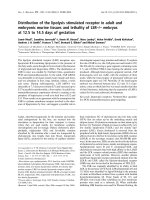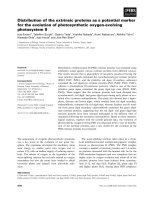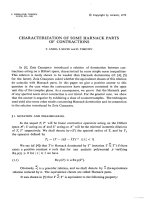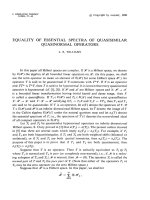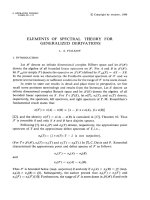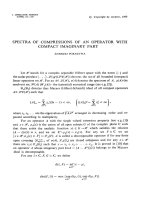Báo cáo toán học: "Distribution of crossings, nestings and alignments of two edges in matchings and partitions" pot
Bạn đang xem bản rút gọn của tài liệu. Xem và tải ngay bản đầy đủ của tài liệu tại đây (223.99 KB, 12 trang )
Distribution of crossings, nestings and alignments of
two edges in matchings and partitions
Anisse Kasraoui and Jiang Zeng
Institut Camille Jordan
Universit´e Claude Bernard (Lyon I)
F-69622, Villeurbanne Cedex, France
,
Submitted: Nov 11, 2005; Accepted: Mar 30, 2006; Published: Apr 4, 2006
Mathematics Subject Classifications: 05A18; 05A15, 05A30
Abstract
We construct an involution on set partitions which keeps track of the numbers
of crossings, nestings and alignments of two edges. We derive then the symmetric
distribution of the numbers of crossings and nestings in partitions, which generalizes
a recent result of Klazar and Noy in perfect matchings. By factorizing our involution
through bijections between set partitions and some path diagrams we obtain the
continued fraction expansions of the corresponding ordinary generating functions.
1 Introduction
A partition of [n]:={1, 2, ··· ,n} is a collection of disjoint nonempty subsets of [n], called
blocks, whose union is [n]. A (perfect) matching of [2n] is a partition of [2n]inn two-
element blocks. The set of partitions (resp. matchings) of [n] will be denoted by Π
n
(resp.
M
n
). A standard way of writing a partition π with k blocks is π = B
1
− B
2
−···−B
k
,
where the blocks are ordered in the increasing order of their minimum elements and,
within each block, the elements are written in the numerical order.
It is convenient to identify a partition of [n]withapartition graph on the vertex set
[n] such that there is an edge joining i and j if and only if i and j are consecutive elements
in a same block. We note such an edge e as a pair (i, j)withi<j, and say that i is the
left-hand endpoint of e and j is the right-hand endpoint of e.Asingleton is the element
of a block which has only one element, so a singleton corresponds to an isolated vertex in
the graph. Conversely, a graph on the vertex set [n] is a partition graph if and only if each
vertex is the left-hand (resp. right-hand) endpoint of at most one edge. By convention,
the vertices 1, 2, ··· ,n are arranged on a line in the increasing order from left to right
andanedge(i, j) is drawn as an arc above the line. An illustration is given in Figure 1.
the electronic journal of combinatorics 13 (2006), #R33 1
1 2 3 4 5 6 7 8 9 10 11
Figure 1: Graph of the partition π = {1, 9, 10}−{2, 3, 7}−{4}−{5, 6, 11}−{8}
Given a partition π of [n], two edges e
1
=(i
1
,j
1
)ande
2
=(i
2
,j
2
)ofπ are said to
form:
(i) a crossing with e
1
as the initial edge if i
1
<i
2
<j
1
<j
2
;
(ii) a nesting with e
2
as interior edge if i
1
<i
2
<j
2
<j
1
;
(iii) an alignment with e
1
as initial edge if i
1
<j
1
≤ i
2
<j
2
.
An illustration of these notions is given in Figure 2.
i
1
i
2
j
1
j
2
i
1
i
2
j
2
j
1
i
1
j
1
i
2
j
2
i
1
j
1
= i
2
j
2
(i)(ii)(iii)
(iii
)
Figure 2: Crossing, nesting and alignments of two edges
The numbers of crossings, nestings and alignments of two edges in π will be denoted by
cr(π), ne(π)andal(π), respectively. For the partition π in Figure 1, we have cr(π)=2,
ne(π)=5andal(π)=8.
Now, assume that B is a partition block with at least two elements. Then an element
of B is said to be:
(i) an opener if it is the least element of B,
(ii) a closer if it is the greatest element of B,
(iii) a transient if it is neither the least nor greatest elements of B.
In a partition graph, the edges around an opener, closer, singleton or transient look as
follows:
Figure 3: Opener, closer, singleton and transient in a partition graph
The sets of openers, closers, singletons and transients of π will be denoted by O(π),
C(π), S(π)andT (π), respectively. The 4-tuple λ(π)=(O(π), C(π), S(π), T (π)) is called
the type of π. For example, for the partition π in Figure 1, we have O(π)={1, 2, 5},
C(π)={7, 10, 11}, S(π)={4, 8} and T (π)={3, 6, 9}.
the electronic journal of combinatorics 13 (2006), #R33 2
Definition 1.1 A 4-tuple λ =(O, C, S, T ) of subsets of [n] is a partition type of [n] if
there exists a partition of [n] whose type is λ. Denote by Π
n
(λ) the set of partitions of
type λ, i.e.,
Π
n
(λ)={π ∈ Π
n
: λ(π)=λ}.
In particular, a partition type λ is a matching type if λ =(O, C):=(O, C, ∅, ∅). Denote
by M
2n
(γ) the set of matchings of type γ, i.e.,
M
2n
(γ)={α ∈M
2n
: O(α)=O and C(α)=C}.
Our main result is the construction of an explicit involution on the set of partitions and
is stated in the following
Theorem 1.2 There is an involution ϕ :Π
n
→ Π
n
preserving the type of partitions and
number of alignments, and exchanging the numbers of crossings and nestings. In other
words, for each π ∈ Π
n
, we have λ(π)=λ(ϕ(π)) and
al(ϕ(π)) = al(π), cr(ϕ(π)) = ne(π), ne(ϕ(π))=cr(π). (1.1)
We derive immediately the following equality of the corresponding generating functions.
Corollary 1.3 For each partition type λ of [n], we have
π∈Π
n
(λ)
p
cr(π)
q
ne(π)
t
al(π)
=
π∈Π
n
(λ)
p
ne(π)
q
cr(π)
t
al(π)
, (1.2)
and for each matching type γ of [2n],
α∈M
2n
(γ)
p
cr(α)
q
ne(α)
t
al(α)
=
α∈M
2n
(γ)
p
ne(α)
q
cr(α)
t
al(α)
. (1.3)
Summing over all partition types λ or matching types γ we get
Corollary 1.4
π∈Π
n
p
cr(π)
q
ne(π)
t
al(π)
=
π∈Π
n
p
ne(π)
q
cr(π)
t
al(π)
, (1.4)
and
α∈M
2n
p
cr(α)
q
ne(α)
t
al(α)
=
α∈M
2n
p
ne(α)
q
cr(α)
t
al(α)
. (1.5)
By specializing t = 1 in the above corollary, we obtain
Corollary 1.5
π∈Π
n
p
cr(π)
q
ne(π)
=
P ∈Π
n
p
ne(π)
q
cr(π)
, (1.6)
and
α∈M
2n
p
cr(α)
q
ne(α)
=
α∈M
2n
p
ne(α)
q
cr(α)
. (1.7)
the electronic journal of combinatorics 13 (2006), #R33 3
Klazar [8] has given a different proof of (1.7) and pointed out that equation (1.7) was first
obtained by Klazar and Noy. Previously the special p = 1 case of (1.7) had been proved
by De Sainte-Catherine [5] and also by De M´edicis and Viennot [4].
We were inspired by the general combinatorial theory of orthogonal polynomials and
continued fractions developed by Viennot [14] and Flajolet [6]. In fact, our involution ϕ
is a direct generalization of that used by De M´edicis and Viennot [4] for matchings. A
variant of this bijection on partitions has been used by Ksavrelof and Zeng [10] to prove
other equinumerous results on partitions.
The rest of this paper is organized as follows: we shall present the involution ϕ and
the proof of theorem 1.1 in section 2; in section 3 we factorize our involution through two
bijections ϕ
l
and ϕ
r
between partitions and Charlier diagrams;insection4,weapplyϕ
l
or ϕ
r
to derive continued fraction expansions of the ordinary generating functions with
respect to the numbers of crossings and nestings of two edges in matchings and partitions.
2 Proof of Theorem 1.2
Let π = B
1
− B
2
−···−B
k
be a partition of [n]andi an integer in [n]. The i-th trace of
π is defined by
T
i
(π)=B
1
(≤ i) − B
2
(≤ i) −···−B
k
(≤ i),
where B
j
(≤ i):=B
j
∩ [i] is the restriction of the block B
j
on [i]. One says that B
j
(≤ i)
is active (resp. closed and empty)ifB
j
⊆ [i] (resp. B
j
⊆ [i]andB
j
∩ [i]=∅).
We shall identify T
i
(π) with the subgraph D
i
(π) of the graph D(π) induced by the
vertex set [i], with the additional condition that for any edge (x, y)ofπ such that x ≤
i<y, we attach a “half-edge” to the vertex x, called vacant vertex.Denotebyl
i
(π)
the number of vacant vertices in D
i−1
(π), with D
0
= ∅.Moreover,ifi is a closer or a
transient, there is an edge (j, i)withj<i,wedenotebyγ
i
(π) the rank of the vertex
j among the vacant vertices of D
i−1
(π), the vacant vertices being arranged from left to
right in the order of their creation, namely, in increasing order.
For instance, if π is the partition given in Figure 1, then
T
5
(π)={1.}−{2, 3.}−{4}−{5.},
T
6
(π)={1.}−{2, 3.}−{4}−{5, 6.},
where each active block is ended with a dot. Hence l
6
(π)=3andγ
6
(π)=3. The
corresponding graphs D
5
(π)andD
6
(π) are given as follows:
1 2 3 4 5 1 2 3 4 5 6
the electronic journal of combinatorics 13 (2006), #R33 4
Now, we can describe our fundamental bijection ϕ on Π
n
using the graphs of traces.
In the following, by “declare the vertex i vacant” we mean “attach a half-edge to the
vertex i”. Let π ∈ Π
n
then ϕ(π) ∈ Π
n
is defined by the following algorithm:
1. Set D
0
= ∅.
2. For 1 ≤ i ≤ n, the graph D
i
is obtained from D
i−1
by adding i as follows:
(i) if i ∈O(π), declare the vertex i vacant.
(ii) if i ∈S(π), add i as an isolated vertex.
(iii) if i ∈C(π) ∪T(π), join i to the γ
i
(π)-th (from right to left) vacant vertex of
D
i−1
.Moreover,ifi ∈ T , declare the vertex i vacant.
3. Set ϕ(π):=D
n
.
For instance, if π is as before, then the step-by-step construction of ϕ(π) is given in
Figure 4 and ϕ(π)={1, 3, 10}−{2, 6, 9, 11}−{4}−{5, 7}−{8}.Asacheck,wenote
that cr(ϕ(π))=ne(π)=5,ne(ϕ(π)) = cr(π)=2andal(ϕ(π)) = al(π)=8.
We shall decompose the proof of Theorem 1.1 in two lemmas.
Lemma 2.1 The m apping ϕ :Π
n
→ Π
n
is an involution which preserves the type.
Proo f. By induction on i (0 ≤ i ≤ n), it is easy to see that D
i
has the same vacant
vertices as D
i
(π). So (iii) is valid and the algorithm is well defined. By inspecting the
algorithm, we see that ϕ(π)hasthesametypeasπ.Toseeϕ is an involution, it suffices
to notice that applying the operation “reverse the order of the vacant vertices in (iii)”
twice is equal to keep the original order.
Remark 2.1 The graph D
i
corresponds with the graph of i-th trace of ϕ(π).
To complete the proof of Theorem 1.1 it remains to verify (1.1). In fact we shall prove
a stronger result. For any closer or transient j of a partition π, let cr(π; j) (resp. ne(π;j)
and al(π; j)) be the number of crossings (resp. nestings and alignments) whose initial
(resp. interior and initial) edge has j as the right-hand endpoint. Clearly
cr(π)=
cr(π;j), ne(π)=
ne(π;j), al(π)=
al(π;j),
where the summations are over j ∈ C(π) ∪ T (π).
Lemma 2.2 Let π be a partition of [n] and j a closer or transient of π. Then
al(ϕ(π);j)=al(π;j), cr(ϕ(π);j)=ne(π;j), ne(ϕ(π);j)=cr(π;j).
the electronic journal of combinatorics 13 (2006), #R33 5
i
γ
i
(π) D
i
(π) D
i
11 1
1 12 23 34 45 56 67 78 89 910 1011 11
10 2
1 12 23 34 45 56 67 78 89 910 10
91
1 1
2 2
2 23 34 45 56 67 78 89 9
8
1 1
2 2
2 23 34 45 56 67 78 8
72
1 1
2 2
2 23 34 45 56 67 7
63
1 1
2 2
2 23 34 45 56 6
5
1 1
2 2
2 23 34 45 5
4
1 1
2 2
3 34 4
32
1 12 23 3
2
1 12 2
1
1 1
Figure 4: Construction of ϕ(π)={1, 3, 10}−{2, 6, 9, 11}−{4}−{5, 7}−{8}
Proo f. For any partition π, the number of alignments with j as the right-hand endpoint,
i.e. al(π; j), is equal to the number of openers and transients which are ≥ j.Now,asϕ(π)
has the same openers and transients as π, we get immediately al(ϕ(π); j) = al(π;j).
Next, in the j-th (1 ≤ j ≤ n − 1) step of the construction of ϕ(π), we add the vertex
j to D
j− 1
for obtaining D
j
.Thereareexactlyl
j
:= l
j
(π) vacant vertices in D
j− 1
(resp.
D
j− 1
). These vertices are smaller than j and arranged from left to right in increasing
order. Suppose that j is linked with the γ
j
-th vacant vertex
¯
j of D
j− 1
in D
j
(resp.
D
j− 1
(π)inD
j
). Recall that the rank of vacant vertices is counted from left to right in
D
j− 1
and from right to left in D
j− 1
.
• Any vacant vertex α on the left of the vertex
¯
j in D
j
(resp. D
j
) will be linked to a
vertex β on the right of the vertex j;thus(α, β) will form a nesting with (
¯
j,j)as
the electronic journal of combinatorics 13 (2006), #R33 6
→
¯
j
j
γ
j
− 1nestings
l
j
− γ
j
crossings
←
¯
j
j
l
j
− γ
j
nestings
γ
j
− 1 crossings
D
j
D
j
Figure 5: Counting of cr(π;j) and cr(ϕ(π); j)
an interior edge in D
n
(resp. D
n
). Conversely, if (a, b) forms a nesting with interior
edge (
¯
j,j), then a must be a vacant vertex on the left of the vertex
¯
j in D
j
(resp.
D
j
) . We deduce that ne(π;j)=γ
j
− 1 and ne(ϕ(π); j) = l
j
− γ
j
.
• Any vacant vertex α between
¯
j and j in D
j
(resp. D
j
) will be linked to a vertex β
on the right of the vertex j;thus(α, β) will form a crossing with initial edge (
¯
j,j).
Conversely, if (a, b) forms a crossing with initial edge (
¯
j,j), then the vertex a must
be a vacant vertex on the right of the vertex
¯
j in D
j
(resp. D
j
). We deduce that
cr(π;j)=l
j
− γ
j
and cr(ϕ(π); j) = γ
j
− 1.
The proof is completed by comparing the above counting results.
3 Factorization of ϕ via Charlier diagrams
3.1 Charlier diagrams
A path of length n is a finite sequence w =(s
0
,s
1
, ··· ,s
n
)ofpointss
i
=(x
i
,y
i
) in the plan
Z×Z.Astep(s
i
,s
i+1
)ofw is East (resp. North-East and South-East)ifs
i+1
=(x
i
+1,y
i
)
(resp. s
i+1
=(x
i
+1,y
i
+1)ands
i+1
=(x
i
+1,y
i
− 1)). The number y
i
is the height of
the step (s
i
,s
i+1
). The integer i +1istheindex of the step (s
i
,s
i+1
).
A Motzkin path is a path w =(s
0
,s
1
, ··· ,s
n
) such that: s
0
=(0, 0), s
n
=(n, 0), each
step is East or North-East or South-East and the height of each step is nonnegative. A
bicolored Motzkin (BM) path is a Motzkin path whose East steps are colored with red or
blue.Arestricted bicolored Motzkin (RBM) path is a BM path whose blue East steps are
of positive height.
In the following, we shall write BE, RE, NE and SE as abbreviations of Blue East,
Red East, North-East and South-East.
Definition 3.1 A Charlier diagram of length n is a pair h =(w,ξ) where w =(s
0
, ,s
n
)
is a RBM path and ξ =(ξ
1
, ,ξ
n
) is a sequence of integers such that ξ
i
=1if the i-th
step is NE or RE, and 1 ≤ ξ
i
≤ h
i
if the i-thstepisSEorBEofheighth
i
.Thesetof
Charlier diagrams of length n is denoted by Γ
n
.
A Charlier diagram is given in Figure 6. The type of a BM path w is the 4-tuple
λ(w)=(O(w), C(w), S(w), T (w)), where O(w) (resp. C(w), S(w), T (w)) is the set of
the electronic journal of combinatorics 13 (2006), #R33 7
indices of NE (resp. SE, RE, BE) steps of w. For instance, if w isthepathinFigure6,
then
λ(w)=({1, 2, 5} , {7, 10, 11} , {4, 8} , {3, 6, 9}).
Denote by M
b
(n) (resp. M
rb
(n)) the set of BM (resp. RBM) paths of length n.
blue red
blue
red blue
1234567891011i
h
i
ξ
i
2
2
33
3
3
2
2
1
2
2
1
1
Figure 6: A Charlier diagram of length 11
There is a well-known bijection (see [6, 14]) from Γ
n
to Π
n
. For our purpose, we present
two variants ϕ
l
and ϕ
r
of this bijection, which keep the track of crossings and nestings.
The description of the bijection ϕ
l
(resp. ϕ
r
) is based on the fact that a partition π of [n]
is completely determined by its type λ =(O, C, S, T ) and the integers γ
i
(π), i ∈C∪T.
Given a Charlier diagram h =(w, ξ)oflengthn, we define the partition π = ϕ
l
(h)as
follows: the type of π is that of w and γ
j
(π):=ξ
j
, for j ∈C∪T.
To define ϕ
l
,wetakeξ
j
as the rank from left to right of the vacant vertex linked to
j in the j-th step of the construction of π.Ifwetakeξ
j
as the rank from right to left of
the vacant vertex linked to j in the j-th step of the construction of π,thenwegetthe
bijection ϕ
r
. Hence we have the identity: ϕ
r
= ϕ ◦ ϕ
l
. In other words, the following
diagram is commutative:
Γ
n
Π
n
Π
n
ϕ
l
ϕ
r
ϕ
Figure 7: Factorization of ϕ
Denote, respectively, by sg(π), bl(π) and tr(π) the numbers of singletons, blocks whose
cardinal number is ≥ 2 and transients of a partition π. The following result is clear (cf.
[6, 14]).
Proposition 3.2 The mappings ϕ
l
and ϕ
r
:Γ
n
→ Π
n
are bijections. Moreover, if h =
(w, ξ) ∈ Γ
n
and π = ϕ
l
(h) or ϕ
r
(h), then sg(π)(resp. bl(π) and tr(π)) is equal to the
number of red East (resp. North-East and blue East) steps of w.
the electronic journal of combinatorics 13 (2006), #R33 8
For instance, if h =(w, ξ) is the Charlier diagram of Figure 6, the construction of
ϕ
l
(h) (resp. ϕ
r
(h)) corresponds with the traces sequence D
i
(π) (resp. D
i
)inFigure4. In
other words, we have
ϕ
l
(h)={1, 9, 10}−{2, 3, 7}−{4}−{5, 6, 11}−{8},
ϕ
r
(h)={1, 3, 10}−{2, 6, 9, 11}−{4}−{5, 7}−{8}.
Proposition 3.3 Let h =(w, ξ) be a Charlier diagram such that the j-th step of w is
blue East or South-East of height k, then
cr(ϕ
r
(h); j) = ne(ϕ
l
(h); j) = ξ
j
− 1
ne(ϕ
r
(h); j) = cr(ϕ
l
(h); j) = k − ξ
j
Proo f. This follows from the proof of Lemma 2.2 by replacing ϕ
l
(h)byπ, ϕ
r
(h)byϕ(π),
l
j
by k and γ
j
by ξ
j
.
A partition π is noncrossing (resp. nonnesting)ifcr(π) = 0 (resp. ne(π)=0). Let
NC
n
(resp. NN
n
) be the set of noncrossing (resp. nonnesting) partitions of [n].
Corollary 3.4 Let 1 denote the n-tuple (1, 1, ,1). Then
(i) The mapping w → ϕ
r
((w, 1)) is a bijection from M
rb
(n) to NC
n
.
(ii) The mapping w → ϕ
l
((w, 1)) is a bijection from M
rb
(n) to NN
n
.
Proo f. Let h =(w,ξ) a restricted diagram and suppose that the j-th step of w is blue
East or South-East. Then, Proposition 3.3 implies that cr(ϕ
r
(h); j) = ne(ϕ
l
(h); j) = ξ
j
−1.
Thus the partition ϕ
r
(h) (resp. ϕ
l
(h)) is noncrossing (resp. nonnesting) if and only if
ξ
i
= 1 for each i.
Note that Corollary 3.4 gives another proof of the well-known fact (see [11] and [12,
p.226]) that the numbers of elements in both NC
n
and NN
n
are equal to the n-th Catalan
number C
n
=
1
n+1
2n
n
. Moreover, the mapping ϕ = ϕ
l
◦ ϕ
−1
r
: NC
n
→ NN
n
is a bijection.
4 Continued fraction expansions
Consider the enumerating polynomial of Π
n
:
B
n
(p, q, u
1
,u
2
,v)=
π∈Π
n
p
cr(π)
q
ne(π)
u
sg(π)
1
u
bl(π)
2
v
tr(π)
,
which is a generalization of n-th Bell numbers.Let
[n]
p,q
=
p
n
− q
n
p − q
, [n]
q
=
1 − q
n
1 − q
.
the electronic journal of combinatorics 13 (2006), #R33 9
It follows from Proposition 3.3 that
B
n
(p, q, u
1
,u
2
,v)
=
(w,ξ)∈Γ
n
j∈O(w)
u
2
j∈S (w)
u
1
j∈C(w)
p
ξ
j
−1
q
h
j
−ξ
j
j∈T (w)
p
ξ
j
−1
q
h
j
−ξ
j
v
, (4.1)
where h
j
is the height of the j-th step of w.
We can rewrite the double sums in (4.1) as a single sum on bicolored Motzkin paths.
For any BM path w, define the weight of a step of w at height k by u
2
(resp. [k]
p,q
,
v[k]
p,q
(1 − δ
0k
), u
1
)ifitisNE(resp. SE,BE,RE)andtheweightP (w)ofw as the
product of weights of its steps. It follows from (4.1) that
B
n
(p, q, u
1
,u
2
,v)=
w∈M
b
(n)
P (w).
Applying a well-known result of Flajolet [6, Propositions 7A and 7B], we derive immedi-
ately the continued fraction expansion from the above correspondence.
Proposition 4.1 The generating function
n≥0
B
n
(p, q, u
1
,u
2
,v) z
n
has the following
continued fraction expansion:
1
1 − u
1
z −
u
2
z
2
1 − (u
1
+ v)z −
u
2
[2]
p,q
z
2
1 − (u
1
+[2]
p,q
v)z −
u
2
[3]
p,q
z
2
1 − (u
1
+[3]
p,q
v)z −
u
2
[4]
p,q
z
2
···
.
Note that the q = v = 1 case of Proposition 4.1 has been given by Biane [1]. Taking
u
1
= u
2
= v =1,wehave:
Corollary 4.2 The generating function
n≥0
(
π∈Π
n
p
cr(π)
q
ne(π)
)z
n
=
n≥0
(
π∈Π
n
q
cr(π)
p
ne(π)
)z
n
has the following continued fraction expansion:
1
1 − z −
z
2
1 − ([1]
p,q
+1)z −
[2]
p,q
z
2
1 − ([2]
p,q
+1)z −
[3]
p,q
z
2
1 − ([3]
p,q
+1)z −
[4]
p,q
z
2
···
.
the electronic journal of combinatorics 13 (2006), #R33 10
For any π ∈ Π
n
,denotebyed(π) the number of edges of π. Clearly we have ed(π)=
bl(π) + tr(π)andcr(π)+ne(π)+al(π)=
ed(π)
2
.Let
E
n
(v, q):=
π∈Π
n
q
cr(π)+ne(π)
v
ed(π)
.
Setting p = q, u
1
=1andu
2
= v in Proposition 4.1, we get
Corollary 4.3 The generating function
n≥0
E
n
(v, q)z
n
has the following continued frac-
tion expansion:
1
1 − z −
vz
2
1 − (1 + v)z −
2qvz
2
1 − (2qv +1)z −
3q
2
vz
2
1 − (3q
2
v +1)z −
4q
3
vz
2
···
.
Let E
n
(v, q)=
k≥0
e
k
(q)v
k
.Then
F
n
(q):=
π∈Π
n
q
al(π)
=
k≥0
q
(
k
2
)
e
k
(1/q).
Finally consider the enumerating polynomials of crossings and nestings of M
2n
:
L
n
(p, q)=
α∈M
2n
p
cr(α)
q
ne(α)
=
α∈M
2n
p
ne(α)
q
cr(α)
.
Setting u
2
=1,u
1
= v = 0 in Proposition 4.1 and replacing z
2
by z we get
Proposition 4.4
n≥0
L
n
(p, q)z
n
=
1
1 −
z
1 −
[2]
p,q
z
1 −
[3]
p,q
z
1 −
[4]
p,q
z
···
.
Note that the p = 1 case of Proposition 4.4 corresponds to a result of Touchard [13].
Since a matching of [2n] has exactly n edges, we get cr(α)+ne(α)+al(α)=
n
2
for any
α ∈M
2n
. Therefore
T
n
(q):=
α∈M
2n
q
al(α)
= q
(
n
2
)
L
n
(1/q, 1/q).
The first terms of the above sequences are given as follows:
T
0
(q)=T
1
(q)=1 L
0
(p, q)=L
1
(p, q)=1
T
2
(q)=2+qL
2
(p, q)=1+p + q
T
3
(q)=6+4q +4q
2
+ q
3
L
3
(p, q)=1+2p +2q +2pq + p
2
+ q
2
+2p
2
q +2pq
2
+ p
3
+ q
3
.
the electronic journal of combinatorics 13 (2006), #R33 11
5 Remarks
Klazar [8] has also a result more general than (1.7), but different from ours. Chen et al [2]
have obtained different equinumerous results on crossings and nestings in matchings and
partitions, while an analogous result for permutations has been given by Corteel [3]. For
a big picture of these results and problems we refer the reader to Krattenthaler’s recent
paper [9].
References
[1] Ph. Biane, Some properties of crossings and partitions, Discrete Math., 175(1997), 41–53.
[2] W. Y. C. Chen, E. Y. P. Deng, R. R. X. Du, R. Stanley et C. H. Yan, Crossings and
nestings of matchings and partitions, preprint, math.CO/0501230, 2005.
[3] S. Corteel, crossings and alignments of permutations, preprint, math.CO/0505031, 2005.
[4] A. de M´edicis et X. Viennot, Moments des q-polynˆomes de Laguerre et la bijection de
Foata-Zeilberger, Adv. Appl. Math., 15 (1994), 262–304.
[5] M. de Sainte-Catherine, Couplage et Pfaffiens en combinatoire, physique et informatique,
Th`ese du 3me cycle, Universit´e de Bordeaux I, 1983.
[6] Ph. Flajolet, Combinatorial aspects of continued fractions, Discrete Math. 41 (1982), 145–
153.
[7] J. Fran¸con and X. Viennot, Permutations selon les pics, creux, doubles descentes, doubles
mont´ees, Discrete Math. 28 (1979), 21–35.
[8] M. Klazar, On identities concerning the numbers of crossings and nestings of two edges in
matchings, preprint, math.CO/0510676, 2005.
[9] C. Krattenthaler, Growth diagrams, and increasing and decreasing chains in fillings of
Ferrers shapes, preprint, math.CO/0503012, 2005.
[10] G. Ksavrelof and J. Zeng, Nouvelles statistiques de partitions pour les q-nombres de Stirling
de seconde esp`ece, Discrete Math, 256 (2002), 743–758.
[11] R. Simion, Non crossing partitions, Discrete Math, 217 (2000), 367–409.
[12] R. Stanley, Enumerative Combinatorics II, Cambridge Studies in Advanced Mathematics,
1999.
[13] J. Touchard, Sur un probl`eme de configurations et sur les fractions continues, Canad. J.
Math, 4 (1952), 2–25.
[14] X. Viennot, Une th´eorie combinatoire des polynˆomes orthogonaux, Lecture Notes, UQAM,
Montr´eal 1983.
the electronic journal of combinatorics 13 (2006), #R33 12
